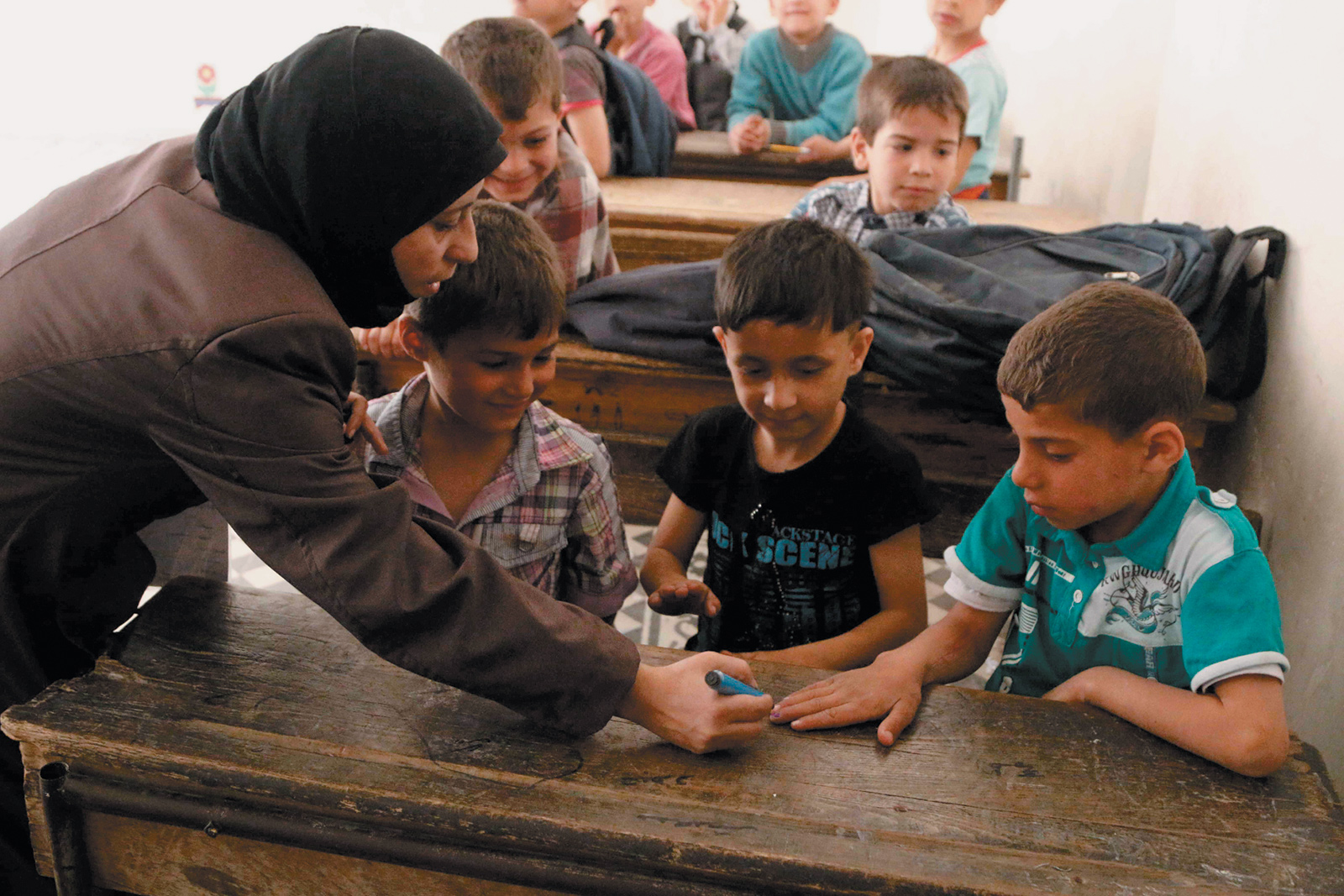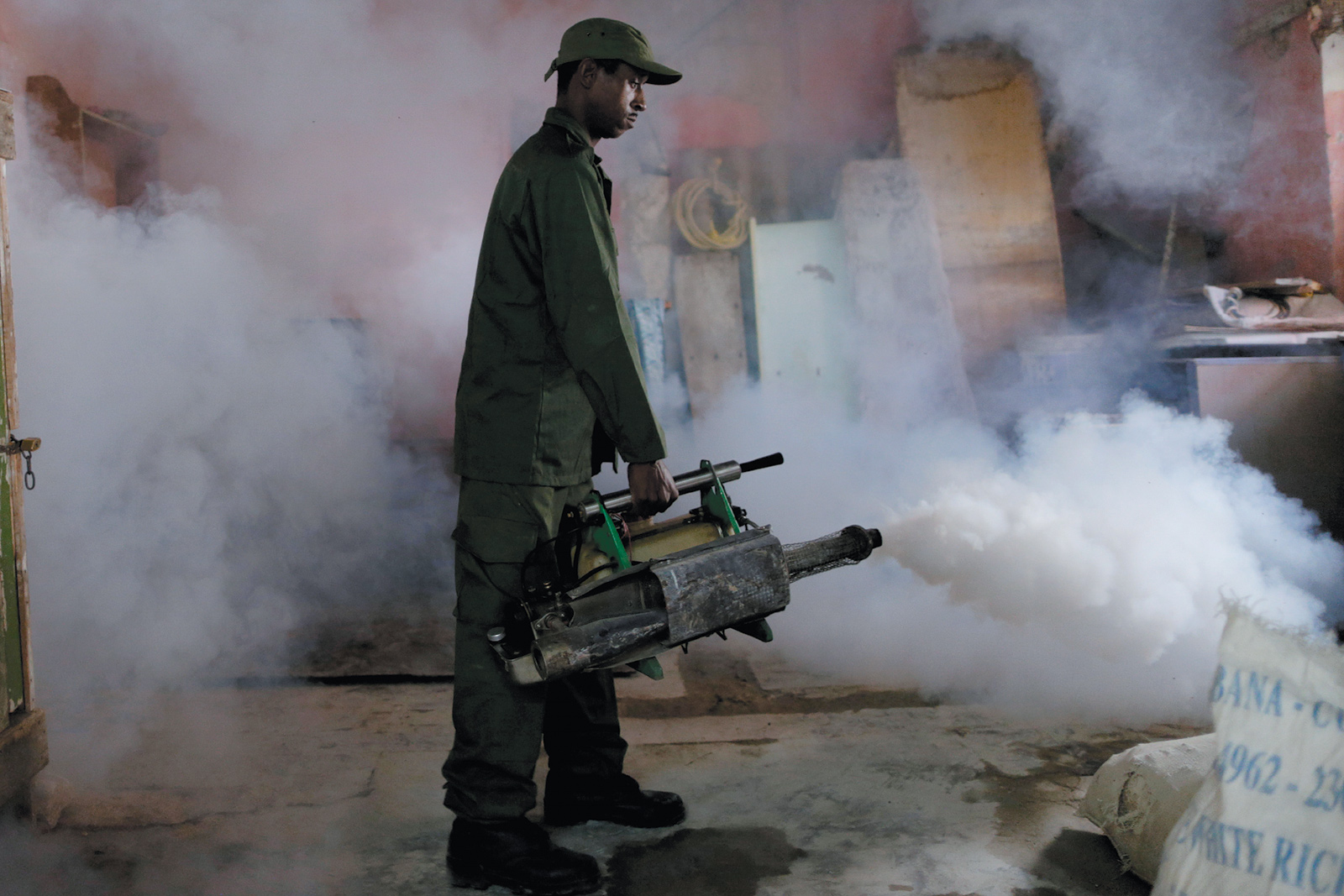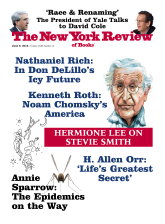Pandemics—the uncontrolled spread of highly contagious diseases across countries and continents—are a modern phenomenon. The word itself, a neologism from Greek words for “all” and “people,” has been used only since the mid-nineteenth century. Epidemics—localized outbreaks of diseases—have always been part of human history, but pandemics require a minimum density of population and an effective means of transport. Since “Spanish” flu burst from the trenches of World War I in 1918, infecting 20 percent of the world’s population and killing upward of 50 million people, fears of a similar pandemic have preoccupied public health practitioners, politicians, and philanthropists. World War II, in which the German army deliberately caused malaria epidemics and the Japanese experimented with anthrax and plague as biological weapons, created new fears.
In response, the US Centers for Disease Control (CDC), founded in 1946 to control malaria domestically, launched its Epidemic Intelligence Service in 1951 to defend against possible biological warfare, an odd emphasis given the uncontrolled polio epidemics raging in the 1940s and 1950s in the United States and Europe. But in the world of public health, the latest threat often takes precedence over the most prevalent.
According to the doctor, writer, and philanthropist Larry Brilliant, “outbreaks are inevitable, pandemics are optional.” Brilliant, a well-known expert on global health, ought to know, since he has had much to do with smallpox eradication. Smallpox, arguably the worst disease in human history, caused half a billion deaths during the twentieth century alone. The strain called Variola major—the most lethal cause—killed one third of all infected and permanently scarred all survivors. In 1975, Rahima Banu, a two-year-old Bangladeshi girl, became the last case of V. major smallpox. Two years later, Ali, a twenty-three-year-old hospital cook in Somalia, became the last case of V. minor. Rahima and Ali survived. Smallpox did not.
Forty years later, smallpox is still the only disease affecting humans ever to have been eradicated. (Rinderpest, a virus affecting cows—literally “cattle plague”—was eradicated in 2011.) There is optimism that polio and guinea worm may soon follow. Meanwhile, dozens of new infectious diseases have emerged, including the pathogens behind the twenty-first-century “pan-epidemics”—a term coined by Dr. Daniel Lucey to describe SARS, avian flu, swine flu, MERS, Ebola, and now Zika.
The fear, fascination, and financial incentives that these new diseases create divert attention and resources from ancient diseases like cholera, malaria, and tuberculosis, which infect and kill far more people. Ebola has caused relatively few deaths, while TB infects 9.6 million people each year and kills 1.5 million, and malaria infects more than 200 million, killing nearly half a million. (Ali, smallpox’s last survivor, later succumbed to malaria.)
Zika virus was first discovered in 1947 in Uganda in monkeys bitten by forest mosquitoes. In recent years, monkeys have sought food outside the forests, and Zika virus has diversified: its carriers now include Aedes aegypti, a tough mosquito with a preference for human blood and urban environments, and it has spread to the Americas. A. aegypti also carries dengue, yellow fever, and West Nile virus, but it is the evolving pan-epidemic of catastrophic birth defects that makes Zika particularly terrifying. In Brazil there have been 1,271 confirmed cases of microcephaly—babies born with severely stunted brains, blindness, and other congenital defects. Cases identified in Colombia, French Polynesia, Panama, Martinique, and Cabo Verde provide advance notice of the likely scale of the damage being wreaked.
Zika provides a devastating backdrop for Sonia Shah’s Pandemic: Tracking Contagions from Cholera to Ebola and Beyond. But far from opportunism, the book represents six years’ work and considerable prescience on Shah’s part. A science writer and investigative journalist, she has a history of taking the long view. Her last book, The Fever, describes how malaria, an ancient parasite acquired from apes, has affected humans for half a million years, becoming a dominant influence on the success or failure of human efforts such as the colonization of North America. The success of the slave trade, for example, depended on the malaria resistance developed over centuries in Africa.
As a doctor of pediatrics and public health, I have treated several hundred malaria patients on three continents during two decades, managed UNICEF’s malaria program in Somalia for the Global Fund to Fight AIDS, Tuberculosis and Malaria, and even contracted malaria myself. I wasn’t convinced I would learn much from Shah, nor did I have time for extraneous reading. Then last year, I found myself on Idjwi, a remote island in the Democratic Republic of Congo, treating scores of seriously ill children with malaria. Lacking electricity for lights, I read The Fever in the last hours of daylight after the clinic had closed. Shah’s synthesis of public health and politics, science and social behavior, provided new insight into malaria’s systematic contagion of mankind. When light faded each evening I dodged mosquitoes to take a brief bath in a lake infested with schistosomiasis, the second-most-common parasitic disease after malaria.
Advertisement
Despite Brilliant’s position that pandemics are optional, the prevailing view in global health is that pandemics are inevitable. Shah’s thesis is that pandemics are the product of complex human behavior. In her view, development, urbanization, and population growth transform harmless animal microbes into human pathogens. Empire-building takes humans into animal habitats, while climate change caused by human activity and deforestation forces animals into urban areas; industrial poultry, cattle, and pig farms also bring humans into greater contact with animals. The “cholera paradigm” is a term coined by the microbiologist Rita Colwell. It means that the environment—biological, social, political, and economic—is both the source and driver of today’s emerging diseases in ways resembling the spread of cholera.
Pandemics are caused by zoonoses—diseases that “jump” from animals to humans. Historically, this was a slow process, requiring considerable personal contact. Malaria took millennia to make the leap from primates to mankind. About ten thousand years ago, the dawn of agriculture and the domestication of livestock led to new levels of intimacy between humans and animals, which encouraged the emergence of our most familiar microbes. Cows gave us measles and TB; pigs gave us pertussis; ducks gave us influenza. Shah notes that, like us, microbes undergo natural selection for survival. Around the same time as the extinction of the smallpox virus, another virus was under threat. When the logging industry in Cameroon reduced the chimp population, simian immunodeficiency virus jumped from chimps to humans—a consequential choice since humans offered a host population of billions.
When HIV appeared, rumors circulated of sexual congress between chimps and people as the means of transmission. In fact, we have our most intimate contact with animals when we consume them. On this point, Shah takes us to the wet markets of Guangzhou, China, where the SARS pandemic started in 2002. The markets flourished in the 1990s, as the rising incomes among China’s elite fed the demand for the wild game cuisine called yewei—including swans, peacocks, snakes, and turtles. Animals that would never be seen next to one another in the wild were forced into close proximity.
Shah gets a good look at the scene in a market in Guangzhou—a turtle in a bucket next to wild ducks and ferrets, snakes close to civets. This unnatural confinement and proximity provides pathogens with the opportunities not only to mutate rapidly but also to jump species. The virus causing SARS spread from horseshoe bats to raccoon dogs, snakes, and civets, mutating along the way until it evolved sufficiently to infect humans.
For centuries, cholera lived undisturbed in tiny crustaceans in the Bay of Bengal, until the arrival of the East India Company in the 1760s. Fishermen and rice farmers colonized five hundred square miles of wetlands, half-immersed in the natural habitat of the bacteria called Vibrio cholerae. Constant exposure to humans led to two important mutations: first, Vibrio grew a long tail that allowed it to, in Shah’s words, “stick to the lining of the human gut like scum on a shower curtain.” A second Vibrio mutation resulted in the toxin that causes massive diarrhea—and that makes cholera stool so infectious.
In 1817, the first cholera pandemic started when Vibrio took advantage of the international traffic on the Spice Route. Since then, there have been seven separate cholera pandemics and hundreds of millions of deaths. Cholera spreads twice as fast as Ebola and kills considerably more quickly. People without detectable symptoms can carry the disease for several weeks, such as UN peacekeepers from Nepal who imported it into Haiti in 2010 with catastrophic and ongoing consequences. Today, cholera infects roughly three million people each year and kills almost 100,000. The seventh pandemic has been underway since 1961 and shows no signs of abating. In less than two hundred years, cholera has become the most successful and enduring of all pathogens. It is the ultimate traveler’s diarrhea.
The cholera bacteria colonized Europe during the second pandemic of 1829–1851. Europeans called it “Asiatic cholera,” assuming Western civilization would be immune. Echoes of this complacency are seen in the modern response to Ebola, which was considered an African disease unworthy of investment until it arrived in Texas in September 2014. Human arrogance was cholera’s advantage: Paris, for example, was completely unprepared for its arrival in March 1832. Bizarrely, in the evenings, the elite dressed up as corpses for “cholera balls,” the inspiration for Edgar Allan Poe’s “Masque of the Red Death.” Shah writes that “cholera killed them so fast they went to their graves still clothed in their costumes”—a detail consistent with the typical onset of cholera’s diarrhea after midnight, followed by massive dehydration and death within hours.
Advertisement
By mid-April, cholera had killed more than seven thousand Parisians. Fifty thousand fled, taking cholera with them. Thousands took advantage of the recently established transatlantic shipping service financed by the Bank of the Manhattan Company, more familiar now as JPMorgan Chase. Many fled to Montreal. The Erie Canal, connecting the Hudson River to Lake Erie, had opened a few years earlier, contributing to New York’s phenomenal commercial success. It also fast-tracked cholera’s journey from Montreal to Manhattan, where conditions for its rapid spread were already in place.
Shah describes those conditions in “Filth,” a chapter devoted to human excrement. She attributes the decline in sanitation in the Middle Ages to the rise of Christianity. Hindus, Buddhists, Muslims, and Jews all have built hygiene into their daily rituals, but Christianity is remarkable for its lack of prescribed sanitary practices. Jesus didn’t wash his hands before sitting down to the Last Supper, setting a bad example for centuries of followers. Christians wrongly blamed plague on water, leading to bans on bathhouses and steam-rooms. Sharing homes with livestock was normal and dung disposal a low priority. Toilets took the form of buckets or open defecation. The perfume industry, covering the stink, thrived.
During the seventeenth century, these medieval practices were exported to Manhattan, where wells for drinking water were only thirty feet deep, easily contaminated by the nightly dump of human waste. Nineteenth-century New Yorkers tried to make their water palatable by boiling it into tea and coffee, which killed cholera. But the arrival of tens of thousands of immigrants overwhelmed these weak defenses, and the city succumbed to two devastating cholera epidemics.
Corrupt economic gain, a recurrent theme in the history of cholera, is illustrated by the story of how a powerful Manhattan company—the future JPMorgan again—was established by diverting money from public waterworks to 40 Wall Street. This resulted in half a century of unsafe drinking water as the city abandoned plans to pump clean water from the Bronx and substituted well water from lower Manhattan slums. In a more recent case, the 2008 subprime mortgage collapse fostered by JPMorgan Chase and others in the banking industry left thousands of homes abandoned in South Florida. Their swimming pools of stagnant water provided ideal breeding grounds when Aedes mosquitoes arrived in 2009 carrying dengue fever. In part as a result, this tropical disease is now reestablished in Florida and Texas, transmitted by the same mosquito that carries yellow fever, West Nile, and Zika virus.
Similarly corrupt schemes by governments have a long history of covering up infectious disease to avoid interrupting trade or tourism. New York’s mayor and board of health denied there was a cholera epidemic in 1832. Italy hid the cholera epidemic of 1911. Assad’s Syria concealed cholera outbreaks in 2008 and 2009. Mugabe’s Zimbabwe denied the 2008 cholera outbreak for months, facilitating its spread to South Africa, Zambia, Mozambique, and Botswana. The Cuban government suppressed reports of its cholera outbreak in 2012. While it is common knowledge that the Chinese government covered up initial reports of SARS in 2002, Shah reveals that the Saudi Arabian government tried to silence the doctor who reported mers, forcing him to resign and relocate to Egypt.
The structure of the World Health Organization (member states elect the same regional directors who must issue quarantines and sanctions against them) lends itself to giving priority to governmental preferences over public health needs, illustrated by WHO’s acquiescence to governmental cover-ups in reporting polio’s reemergence in Syria in 2013 and the Ebola outbreak in Guinea in 2014. The cover-up in Zimbabwe was assisted by the United Nations, which has also consistently denied its role and responsibility in importing cholera into Haiti.
Shah’s book should be required reading for anyone working in global health. It should also alert a much wider audience to the ways that many kinds of the microorganisms called pathogens have caused Western pandemics of chronic, or so-called noncommunicable, diseases. Many of our most familiar diseases are set off or directly caused by pathogens. Viruses lie behind at least 25 percent of all cancers. Cervical cancer, for example, the second-most-common cancer among women worldwide, is caused by human papillomavirus (HPV). Infestation by the bacteria Helicobacter pylori is a common cause of ulcers, but also causes gastric cancer and lymphoma. Epstein-Barr virus causes Burkitt’s lymphoma, leukemia, and gastric, breast, and ovarian cancer. Hepatitis B and C cause liver cancer. Herpes virus can cause brain tumors and Kaposi’s sarcoma. Even psychiatric diseases are linked to pathogens: a few years after influenza outbreaks, schizophrenia is more commonly diagnosed. Babies exposed to flu and herpes in utero are at greater risk of autism. Lyme disease can cause depression and dementia.
Moreover, the phenomenal success of the HPV vaccine in protecting teenage girls from infection shows us that cervical cancer is a disease that can be prevented by vaccine. H. pylori infestation is readily treated with two weeks of antibiotics and acid-blocking agents.
The smallpox vaccine was developed in 1796, but it took 170 years and mandatory vaccination to eradicate this pox. Measles is the most contagious disease on earth, and the measles vaccine the most cost-effective public health intervention we have, but the false and financially motivated connection made in 1998 between the measles vaccine and autism has permanently damaged the eradication effort. The consequence goes well beyond a global measles revival: several studies show that the measles vaccine, known as a live or attenuated vaccine, also reduces child mortality from infectious diseases such as malaria, pneumonia, and pertussis by 30 to 80 percent. But that effect lasts only until an inactivated vaccine is given—usually a diphtheria-pertussis-tetanus booster—at eighteen months.
This suggests that changing the childhood vaccination schedule could have deep effects. Universal measles vaccinations in adulthood might protect us from Zika, future pathogens, even the viruses behind today’s cancer epidemics. It could also provide important protection for populations in disaster and war, such as the millions in Syria, with immunity compromised by malnutrition, crowding, and contaminated water.
Much of human history can be seen as a struggle for survival between humans and microbes. Pandemics are microbe offensives; public health measures are human defenses. Water purification, sanitation, and vaccination are crucial to our living longer, better, even taller lives. But these measures of mass salvation are not sexy. While we know prevention is better and considerably cheaper than cure, there is little financial reward or glory in it. Philanthropists prefer to build hospitals rather than pay community health workers. Pharmaceutical companies prefer the Western market to the distant and poor Global South where people cannot afford to buy treatments. Education is a powerful social vaccine against the ignorance that enables pathogens to flourish, but insufficient to overcome the corruption of public goods by private interests. The current enthusiasm for detecting the next panic-inducing pathogen should not divert resources and research from the perennial threats that we already have. We must resist the tendency of familiarity and past failures to encourage contempt and indifference.
The ideal in public health is to protect everyone. Shah explicates why as the rich get richer, the poor get infectious diseases, and also reiterates that pathogens with the means to travel respect neither class nor position. When it comes to susceptibility to new organisms and biological weapons, in a hyperconnected world we are all vulnerable. The first case in a pandemic is most likely to emerge from war and poverty. Current conflicts in the Middle East and Africa have created the biggest population of refugees and displaced people since World War II—a flood of malnourished people highly vulnerable to new and old pathogens. Investments in public health in those areas that are likely to be the source of new pandemics will protect not only the 99 percent but also the one percent.
Preventing pandemics requires pragmatic solutions—doing what works—to protect people from infectious diseases. This means investing in a global supply of vaccines for cholera, hepatitis, tuberculosis; funding local people to implement vaccination campaigns in the populations at risk; sterilizing mosquitoes, which would help control not only Zika but also dengue, yellow fever, and malaria; and universal measles coverage. Such practical solutions are likely to be cost-effective, as well as provide the broadest feasible protection against current and future pathogens.





